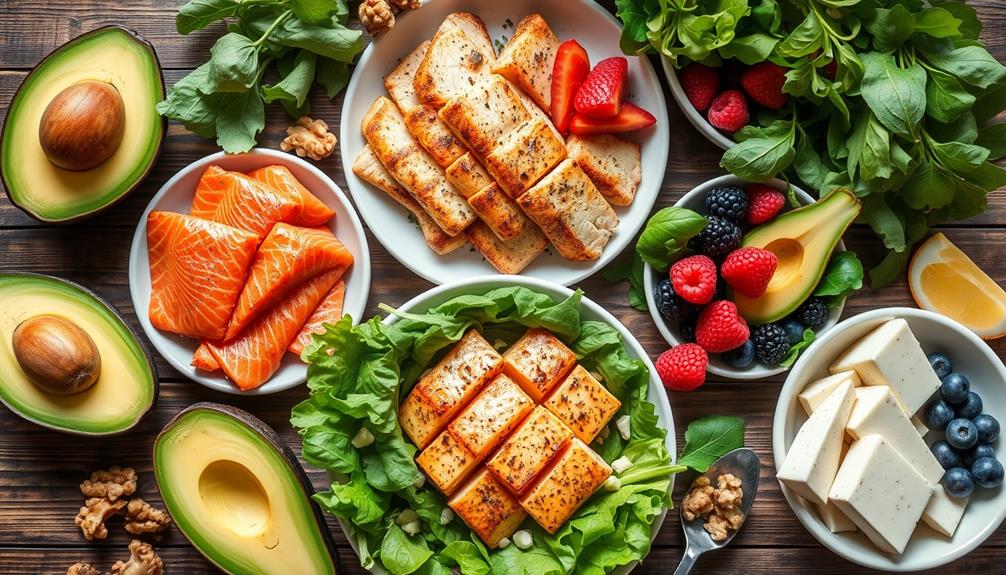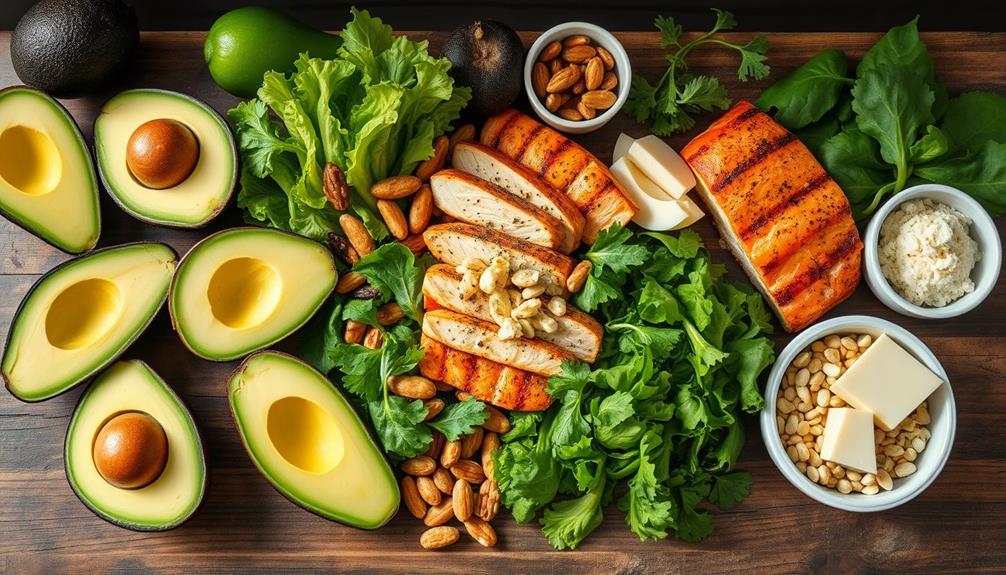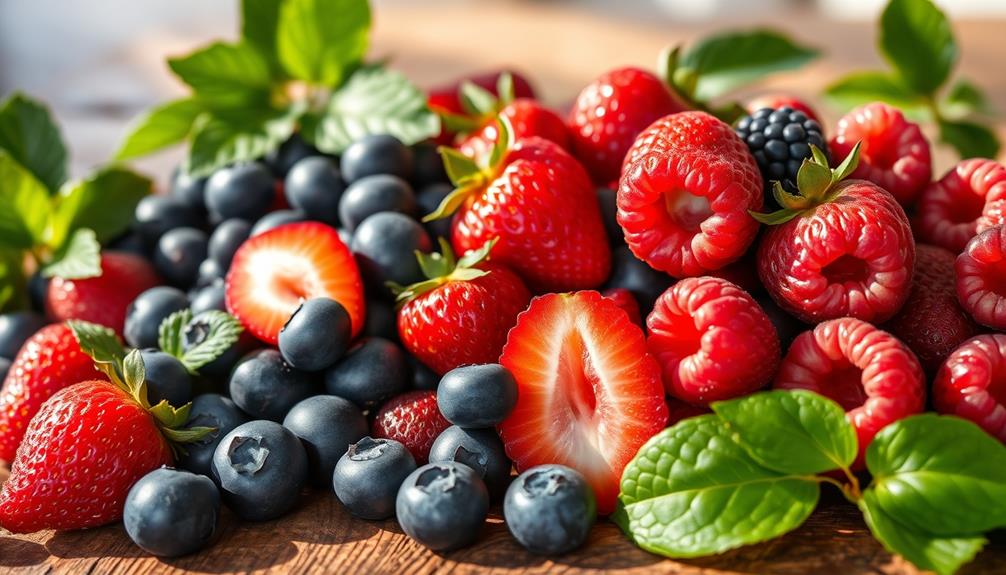On a keto diet, you'll want to focus on low-carb and high-fat foods that keep you in ketosis. Opt for fatty cuts of meat, fatty fish like salmon, and plenty of eggs. Incorporate healthy fats like olive oil, coconut oil, and avocados. Fill your plate with low-carb vegetables such as spinach, broccoli, and zucchini. Don't forget snacks like nuts, seeds, or cheese crisps for quick energy. Berries in moderation can also satisfy your sweet tooth while keeping carbs low. Interested in more tips on meal prep and food choices? There's plenty more to explore! If you’re looking for more ketofriendly food ideas, consider incorporating dairy products like full-fat yogurt or cheese, as well as sugar-free condiments and sauces. You can also experiment with keto-friendly alternatives to traditional carbs, such as cauliflower rice or zucchini noodles. Meal prepping can also make it easier to stick to your keto diet, so consider cooking large batches of keto-friendly dishes like casseroles or salads to enjoy throughout the week. With a little creativity and planning, you can enjoy delicious and satisfying meals while staying in ketosis.
Key Takeaways
- Focus on high-quality proteins like fatty fish, eggs, and grass-fed meats to maintain ketosis and muscle mass.
- Incorporate healthy fats such as olive oil, coconut oil, and avocados for energy and satiety.
- Choose low-carb vegetables like spinach, broccoli, and zucchini to maximize nutrients without exceeding carb limits.
- Include nuts and seeds, such as almonds and chia seeds, for healthy fats and essential nutrients, while monitoring portion sizes.
- Opt for low-carb fruits like raspberries and strawberries to satisfy sweet cravings without hindering ketosis.
Overview of the Keto Diet
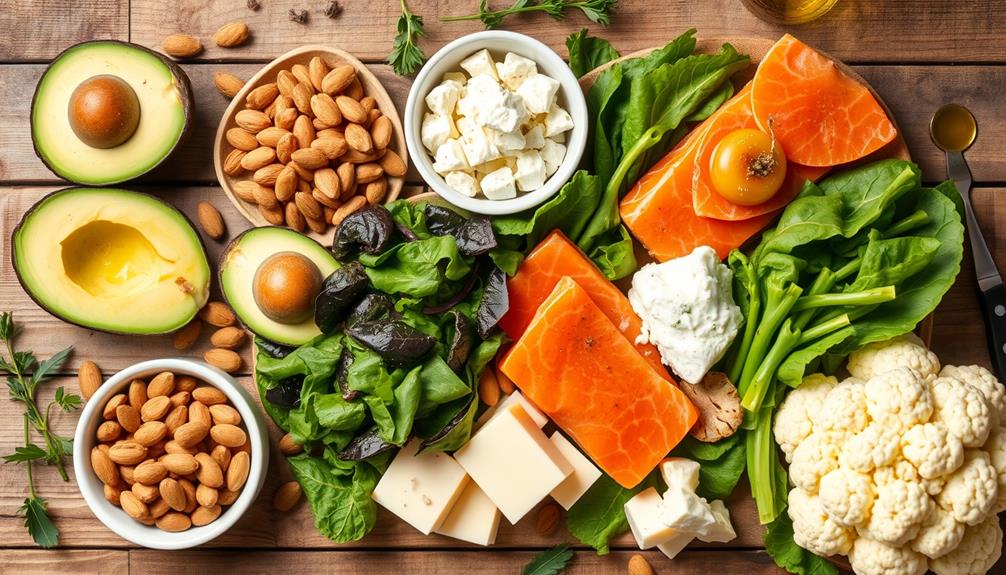
The ketogenic diet, often referred to simply as keto, focuses on drastically reducing your carbohydrate intake while increasing fat consumption. This low-carbohydrate, high-fat approach typically consists of 70-80% of your daily caloric intake coming from fats. By limiting carbohydrates to about 20 to 50 grams daily, you aim to induce a metabolic state called ketosis, where your body shifts from burning glucose to burning fat for fuel.
Additionally, incorporating foods rich in antioxidants, like those found in celery juice, can support overall health and enhance your dietary routine.
On the keto diet, you'll enjoy high-quality proteins from sources like meat, poultry, and fatty fish, alongside nutrient-dense low-carb vegetables. These foods provide essential nutrients while keeping your carbohydrate levels in check.
Healthy fats from avocados, nuts, seeds, and oils are vital for maintaining energy and promoting satiety, ensuring you feel full and satisfied throughout the day. It's important to avoid processed and high-carb foods, as they can hinder your progress.
Many people experience rapid weight loss on the keto diet, and it may also help with blood sugar control and increasing HDL cholesterol levels. While the short-term benefits are notable, it's wise to reflect on long-term adherence and potential health implications.
Benefits of the Keto Diet
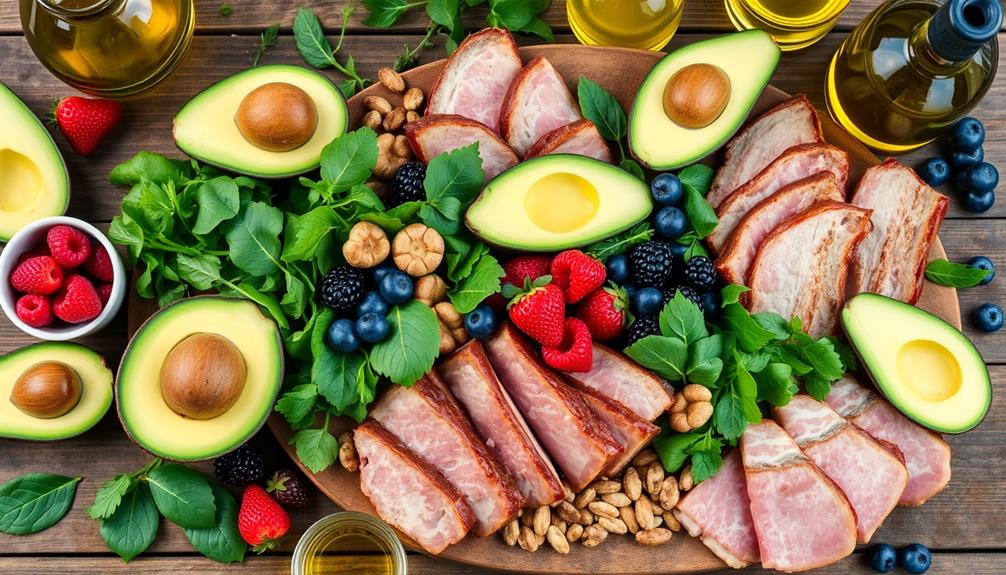
Many people find that the keto diet offers a range of benefits beyond just weight loss. By cutting carbs and emphasizing high-fat content, you can enjoy various health advantages:
- Enhanced cardiovascular health
- Improved insulin sensitivity
- Effective blood sugar control
- Increased feelings of satiety
The keto diet promotes weight loss by shifting your metabolism to burn fat for energy instead of carbohydrates. This often results in rapid initial weight loss, as glycogen stores deplete along with associated water weight.
Additionally, research shows that this diet can improve metabolic markers in those with obesity, leading to higher HDL (good) cholesterol and lower triglycerides. In addition, adopting a balanced diet rich in fruits and vegetables can complement the keto approach, further enhancing overall health and longevity a balanced diet.
For individuals with type 2 diabetes, the keto diet can be particularly beneficial. By greatly reducing carbohydrate intake, it helps improve blood sugar control and insulin sensitivity.
Furthermore, the high-fat content can lead to increased satiety, allowing you to consume fewer calories overall while maintaining weight loss. Some studies even suggest that the ketogenic diet may provide neuroprotective effects, potentially benefiting conditions like epilepsy and Alzheimer's due to its influence on brain metabolism.
Animal Proteins
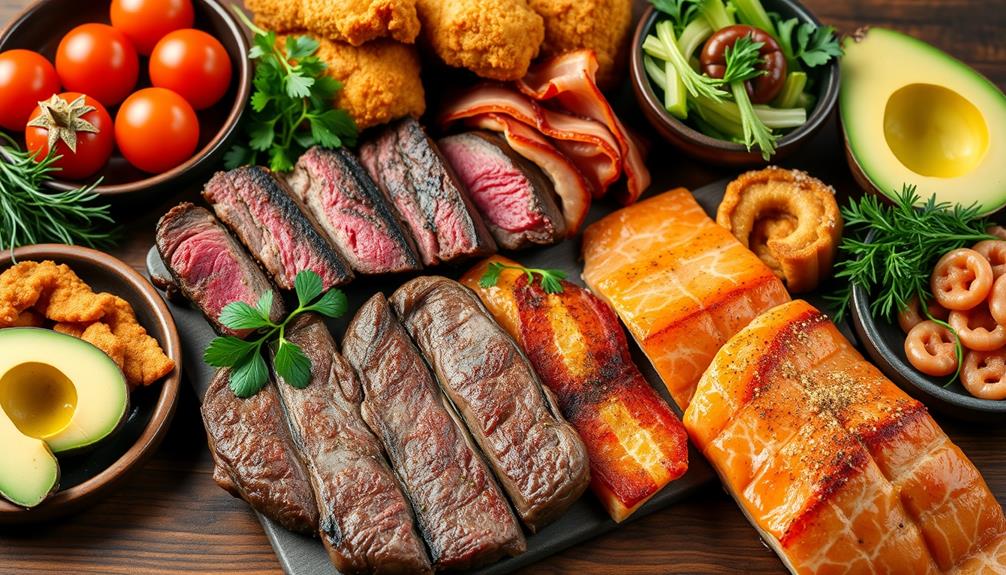
Incorporating animal proteins into your keto diet is vital for maintaining ketosis and reaping its benefits. These proteins, including seafood, meat, poultry, and eggs, are high in fat and low in carbohydrates, making them perfect for promoting ketosis. Fatty fish like salmon are particularly beneficial due to their high omega-3 fatty acids, which can improve brain health and reduce inflammation.
Additionally, it's important to take into account the nutritional aspects of your food choices, such as the impact of cold medications on appetite and overall health.
Fresh meat and poultry contain no carbohydrates and provide high-quality protein, helping you preserve muscle mass while on a low-carb intake. Each large egg has less than 1 gram of carbohydrates and around 6 grams of protein, making them a versatile and nutrient-dense option for your keto meals. You can whip up delicious omelets or add them to salads for an extra protein boost.
Think about choosing grass-fed meat options as they offer additional health benefits, including higher levels of omega-3 fats and conjugated linoleic acid (CLA), which may support fat loss and overall health.
Healthy Fats and Oils
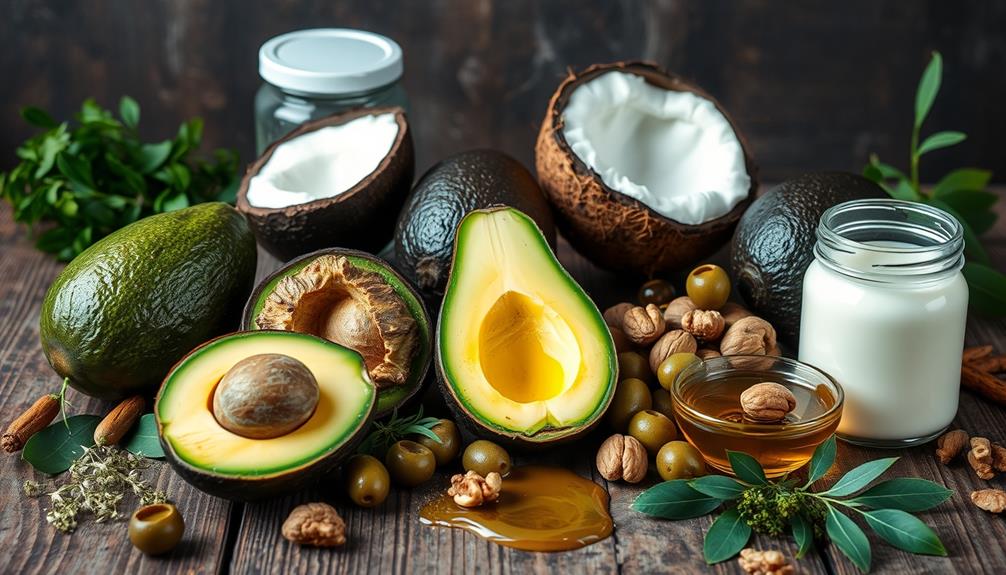
Healthy Fats and Oils
While animal proteins form the backbone of your keto diet, healthy fats and oils play an essential role in fueling your body and keeping you satisfied. Incorporating the right fats not only enhances flavor but also supports your overall health.
Different brewing methods can also influence the health benefits of your coffee, as seen in various brewing methods that affect caffeine levels considerably. Here are some top picks for your keto kitchen:
- Olive oil: Packed with monounsaturated fats and antioxidants, it's great for heart health.
- Coconut oil: Rich in medium-chain triglycerides (MCTs), it quickly converts to ketones, providing a powerful energy source.
- Avocado oil: High in oleic acid, it helps lower bad cholesterol levels, promoting overall heart health.
- Butter and ghee: Both are excellent for cooking; ghee is carb-free and adds a rich flavor to your dishes.
Using these healthy fats will keep you full longer and help you maintain ketosis.
Remember, the quality of fats you consume matters, so opt for extra virgin olive oil, organic coconut oil, and pure avocado oil whenever possible.
Low-Carb Vegetables

When you're following a keto diet, incorporating low-carb vegetables can really boost your meals.
These nutrient-dense choices not only add flavor and texture but also offer various cooking methods and meal pairing ideas to keep your dishes exciting.
By focusing on a balanced approach to your diet, you can guarantee that you're also managing your budget effectively while enjoying your meals.
Remember, a well-planned budget is essential for maintaining financial health as you explore common financial terms.
Let's explore how to make the most of these veggies for your keto journey.
Nutrient-Dense Choices
Low-carb vegetables are a cornerstone of any ketogenic diet, offering a wealth of nutrients without the excess carbohydrates. These nutrient-dense choices not only support your healthy eating goals but also guarantee you're getting essential vitamins and minerals.
By incorporating a variety of low-carb vegetables into your meals, you can boost your nutrient density while keeping your carb intake low.
- Spinach and kale: Packed with vitamins and minerals, they're perfect for salads or smoothies.
- Broccoli and cauliflower: Non-starchy vegetables that provide less than 8 grams of net carbs per cup, along with essential antioxidants.
- Zucchini: A versatile option that can be spiralized into noodles, making it an excellent pasta substitute.
- Green beans: Low in calories and carbs, they offer fiber and vitamin C for enhanced overall health.
Cooking Methods
Incorporating various cooking methods can elevate your experience with low-carb vegetables, making them more enjoyable and flavorful. Techniques like sautéing, roasting, and grilling can transform veggies like cauliflower and zucchini into delicious side dishes that enhance your keto meals.
For instance, sautéing non-starchy vegetables such as bell peppers and spinach in olive oil not only boosts flavor but also adds healthy fats, improving nutrient absorption.
Roasting low-carb vegetables like asparagus or Brussels sprouts can impart a smoky flavor that makes them irresistible. You'll find that grilling also adds a delightful char, enhancing the overall taste and encouraging you to eat more vegetables.
If you're looking for alternatives to traditional pasta, spiralizing zucchini into noodles offers a satisfying low-carb option.
Cauliflower deserves special mention, as it can be mashed or riced for a versatile substitute to high-carb grains and potatoes. With only about 5g net carbs per cup, it fits perfectly into your keto diet.
Meal Pairing Ideas
Discovering delicious meal pairing ideas can make your keto journey even more enjoyable. Incorporating low-carb vegetables into your meals not only keeps your net carbs low but also boosts your intake of essential vitamins and nutrients.
Here are some tasty pairings to try:
- Zucchini noodles with olive oil and garlic
- Roasted broccoli topped with parmesan cheese
- Stuffed bell peppers filled with ground meat and cheese
- Sautéed spinach with butter and garlic
These options aren't just delicious; they're nutrient-dense too! For instance, spiralized zucchini offers about 4g of net carbs per medium veggie, while sautéed spinach has less than 1g per cup.
Broccoli, roasted with olive oil, contains around 4g of net carbs and is rich in vitamins. Bell peppers, when stuffed, average 6g of net carbs and are a great way to enjoy protein and cheese together.
Nuts and Seeds
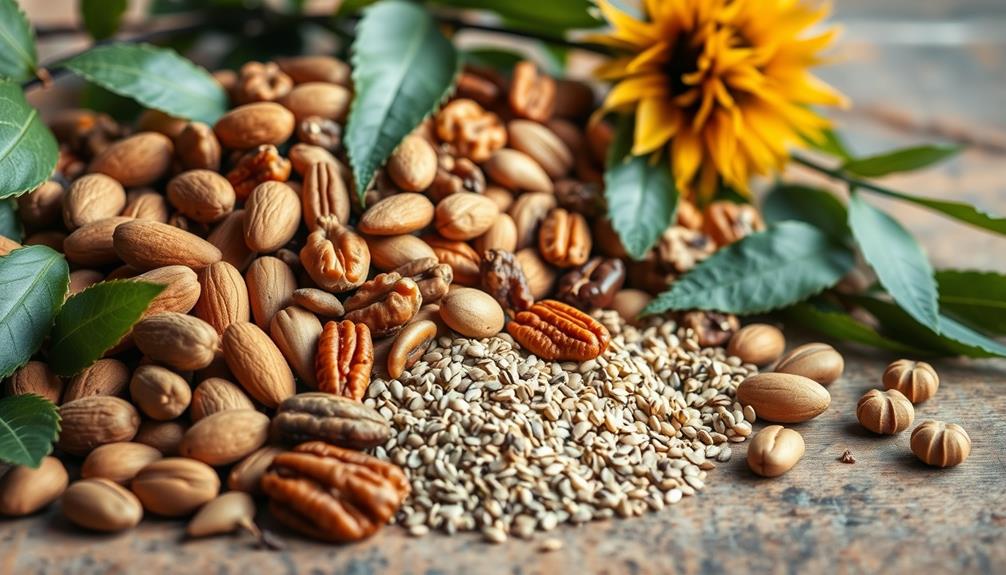
Packed with healthy fats and essential nutrients, nuts and seeds are a fantastic choice for anyone following a keto diet. These snacks are low in carbohydrates, making them perfect for keeping your carb intake in check.
For instance, almonds offer about 6 grams of carbs per ounce, but with 3.5 grams of fiber, they result in just 2.5 grams of net carbs. This promotes satiety and supports heart health.
Walnuts are another excellent option, rich in omega-3 fatty acids, containing around 4 grams of net carbs per ounce. They're great for brain health and reducing inflammation.
Don't overlook chia seeds, either; they provide 12 grams of carbs per ounce but boast 10 grams of fiber, resulting in only 2 grams of net carbs, along with valuable antioxidants.
However, it's essential to practice portion control with nuts and seeds due to their calorie density. A small handful can pack around 150-200 calories.
Berries
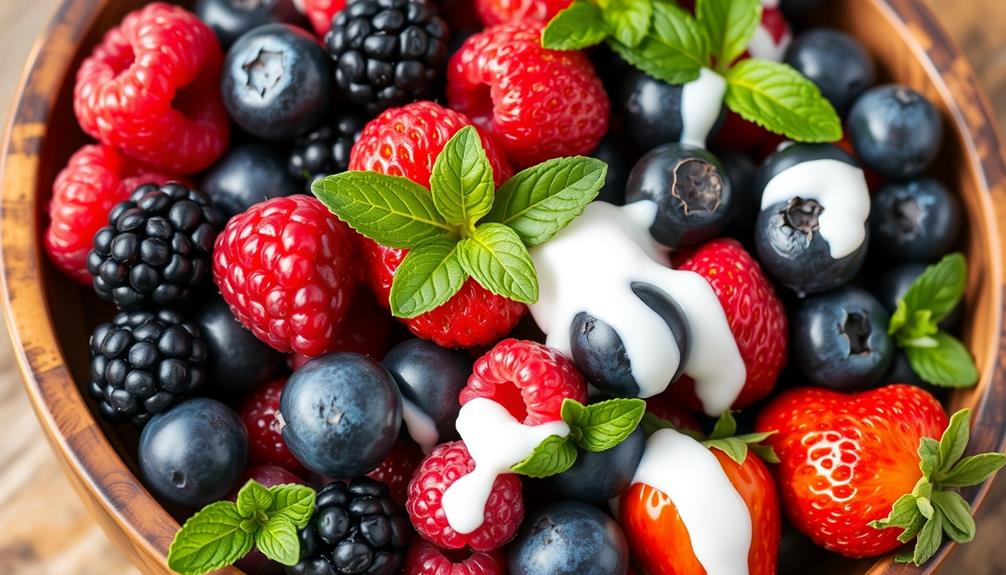
When you're on a keto diet, berries can be your go-to low-carb fruit option.
Raspberries, strawberries, and blackberries not only satisfy your sweet tooth but also pack a punch with essential nutrients and antioxidants.
Let's explore the best berry choices and their impressive health benefits.
Low-Carb Fruit Options
If you're looking for low-carb fruit options on a keto diet, berries are a top choice. These delicious fruits not only satisfy your sweet cravings but also keep your carbohydrate intake in check. Here are some highlights:
- Raspberries: About 3g net carbs and 4g fiber per 1/2 cup.
- Strawberries: Approximately 6g carbohydrates and 2g fiber per 1/2 cup.
- Blackberries: Around 7g carbohydrates and 3g fiber per 1/2 cup.
- Blueberries: Typically contain 9g carbohydrates per 1/2 cup.
Berries are among the lowest sugar fruits, making them compatible with your keto diet. With net carb counts ranging from 3g to 9g per 1/2 cup serving, they're a great way to enjoy healthy foods without derailing your progress.
Raspberries, for example, not only provide fiber to promote digestive health but also help you feel full longer. Incorporating low-carb berries into your meals can enhance flavor and nutrition, all while keeping your carbohydrate intake low.
Enjoy them in moderation to reap the benefits without greatly impacting your keto journey!
Nutritional Benefits of Berries
Berries frequently stand out as a nutritional powerhouse, especially for those on a keto diet. Low in net carbs and rich in essential nutrients, berries like strawberries, raspberries, and blackberries offer a delicious way to support your health while keeping your carb intake in check.
| Nutrient | Benefits |
|---|---|
| Net Carbs | Low in net carbs (e.g., 8g carbs, 2g fiber in ½ cup strawberries) |
| Antioxidants | Protect against oxidative stress and inflammation |
| Dietary Fiber | Aids digestion and promotes feelings of fullness |
| Heart Health | Linked to improved heart health, lowering blood pressure and cholesterol |
Incorporating berries into your diet provides numerous health benefits. They're packed with vitamin C, which supports your immune system, while their antioxidants help combat chronic diseases. The high dietary fiber content not only aids digestion but also helps control appetite and promote feelings of fullness, essential for sticking to your low-carb goals. Just remember to be mindful of portion sizes to maintain that perfect balance on your keto journey. Enjoy the vibrant flavors and health benefits that berries have to offer!
Best Berry Choices
Choosing the right types of berries can enhance your keto experience while providing valuable nutrients. Berries are among the lowest-sugar fruits, making them perfect for a keto diet. Here are some of the best options to weigh:
- Raspberries: About 14 grams of net carbs per cup.
- Strawberries: Approximately 11 grams of net carbs per cup.
- Blackberries: Around 10 grams of net carbs per cup, with 7 grams of high fiber.
- Blueberries: Contain about 12 grams of net carbs per cup and boast antioxidant properties.
Including berries in your meals not only adds flavor and variety but also supports your overall health. Their high fiber content helps promote digestive health, making them a smart choice.
When enjoying mixed berries, a serving of just ½ cup yields about 5-7 grams of net carbs, allowing you to indulge without overdoing it.
However, moderation is key, as even these low-sugar fruits can quickly increase your carb intake. Keep an eye on your portions to stay within your daily limits while still enjoying the delicious benefits of berries on your keto journey.
Dairy Products
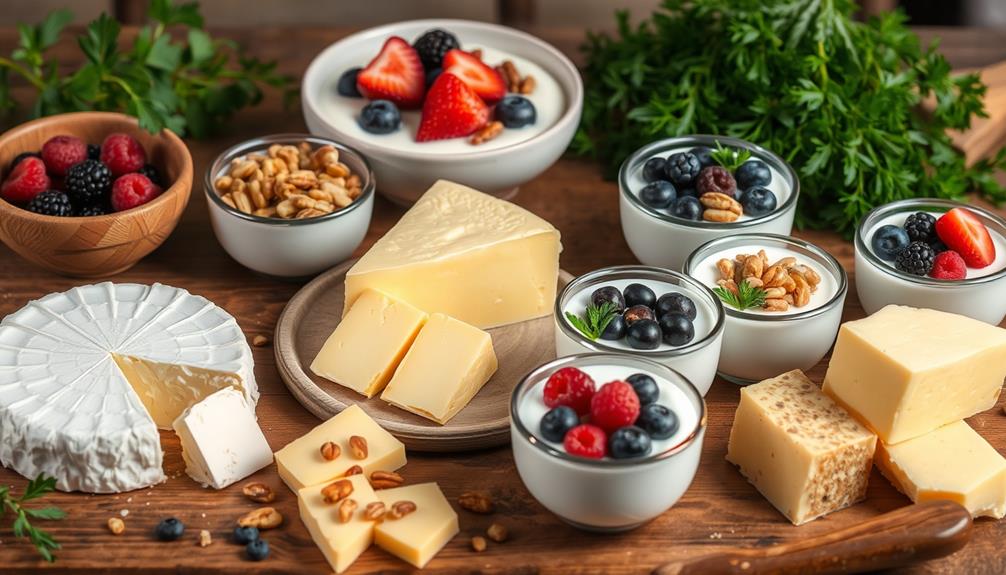
Dairy products play an essential role in the keto diet, offering a delicious way to boost your intake of healthy fats and protein. Many cheese options, like cheddar and blue cheese, are low in carbs, making them perfect for your meals.
For instance, cheddar contains about 1g of carbs per ounce, while blue cheese has approximately 0.66g. These high-fat cheeses not only enhance flavor but also provide essential nutrients.
Full-fat Greek yogurt is another great choice, delivering around 20g of protein and 8g of carbs per 7-ounce serving. Just remember to consume it in moderation to stay within your carb limits.
Heavy cream and half-and-half are also low in carbs, typically containing less than 1g per tablespoon, making them ideal for coffee or cooking to increase fat content.
Cottage cheese does have slightly more carbs, with over 6g per serving, but it's still a solid source of protein and calcium. This can help keep you feeling full and satisfied on your keto journey.
Meal Preparation Tips
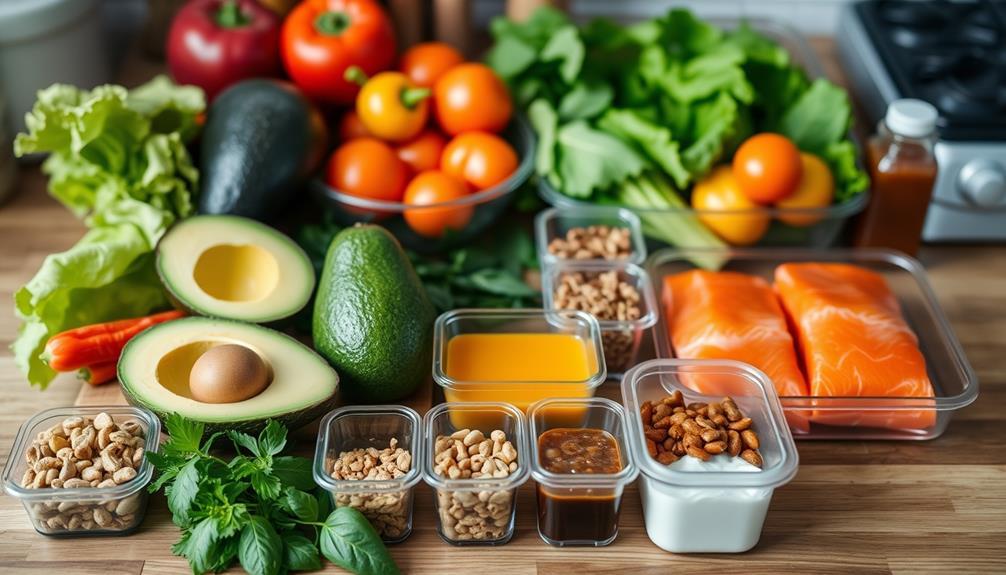
To stay on track with your keto diet, effective meal preparation is essential. By planning your meals ahead of time, you can guarantee a balanced nutrient intake that aligns with your goals.
Here are some meal prep strategies to simplify your keto journey:
- Focus on low-carb vegetables like spinach and zucchini.
- Incorporate high-quality proteins such as chicken and fish.
- Use healthy fats, including avocados and olive oil.
- Prepare healthy snacks like cheese and nuts for quick access.
Batch cooking and portioning meals can help you avoid high-carb temptations during busy weeks.
Versatile ingredients like eggs and leafy greens make meal planning easier, allowing for multiple uses throughout the week.
Don't forget to utilize food scales and tracking apps to monitor your micronutrient intake and guarantee you stay within your carbohydrate limit of 20-50 grams per day.
With a little effort in meal preparation, you'll find sticking to your keto diet becomes a lot more manageable. Enjoy the process and savor each bite!
Frequently Asked Questions
What Are the Best Foods to Eat on Keto?
When considering your food choices, focus on fresh meats, fatty fish, low-carb vegetables, eggs, and healthy fats like olive or coconut oil. These options support your goals while keeping your meals delicious and satisfying.
What Is the Most Filling Food on Keto?
When you're craving something that sticks to your ribs, try avocados or ribeye steak. They're packed with healthy fats and protein, keeping you full longer while satisfying your taste buds on your keto journey.
What Food Is Not Allowed in Keto?
On a keto diet, you shouldn't eat high-carb foods like bread, pasta, and sugary fruits. Starchy veggies, legumes, and sweets also need to go if you want to maintain ketosis and reach your goals.
What Are the 9 Rules of Keto?
Did you know nearly 70% of the population struggles with weight management? To succeed on keto, you'll need to limit carbs, prioritize fats, track macros, hydrate, avoid processed foods, and consider electrolytes for balance.
Conclusion
In the garden of health, the keto diet serves as a sturdy fence, protecting you from the weeds of excess carbs. By choosing vibrant vegetables, rich proteins, and nourishing fats, you cultivate a flourishing patch of energy. Just as a gardener patiently tends to their plants, you'll find success in meal preparation and mindful eating. Embrace this journey, and watch your body blossom into its best self, thriving under the sun of wholesome choices and balanced nutrition.
